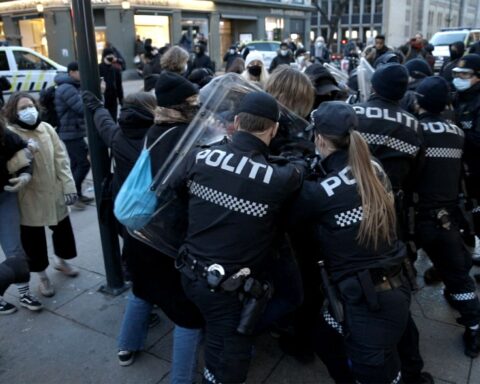McQueen
(USA, 111 min.)
Dir. Ian Bonhôte and Peter Ettedgui
Programme: Special Presentations (International Premiere)
Move over, Daniel Day-Lewis! The gorgeous gowns of the House of Woodcock have nothing on the threads of Lee Alexander McQueen. Mind you, the designer of Phantom Thread never had the stones to let a boob hang out of his dresses, nor did he have the audacity to channel his culture of toxic masculinity into his clothes. The iconoclastic McQueen, however, had a wardrobe full of violent and visceral get-ups that repulsed and ravished onlookers with their unconventional elegance. This doc by Ian Bonhôte and Peter Ettedgui weaves a phantom thread of its own by designing a chic portrait of the late Alexander McQueen. The film haunts long after the credits roll.
McQueen mines the designer’s archival tapes to chart his career through five chapters and pivotal fashion collections. Rough and tumble VHS footage introduces a young McQueen who seems an unlikely figure to conquer the fashion world. Coarse, portly, and dressed like a bum, McQueen hailed from a working class family in Stratford, England and started stitching as a tailor’s apprentice at Savile Row in true rags to riches fashion. His early days were far from the hoity-toity origins of his future clients and arguably helped his singular voice shock the London scene.
Each chapter culminates with a show that defined McQueen’s evolution as a designer. The first, “Jack the Ripper Stalks His Victims,” showcases the designs from McQueen’s 1992 graduate collection that resulted from his studies at the prestigious Center St. Martin’s fashion school. These designs still have shock value as they evoke pain and pleasure with blood-red fabric and violent cuts. The second chapter offers his controversial professional debut “Highland Rape,” which featured models dishevelled, gnarled, and exposed. The fashion show, revealed in archival footage, is as far removed from haute couture as possible, but a blood-curdling scream of originality in a stale fashion scene. These first two collections introduced a dialogue of misogyny that hung atop McQueen’s designs like a shroud. Particularly controversial were his creative choices in staging models like stylish victims who stumbled down the runaway as if emerging from a gang rape. Even Reynolds Woodcock gave the public appearance of being respectful to women.
McQueen smartly engages in a dialogue with the designer’s work using a range of talking heads who speak to his personal and professional character. Interviewees include stylist Mira Chai Hyde and assistant designer Sebastian Pons, who both offer a great deal of insight as McQueen’s long time collaborators and friends. Equally pivotal is art dealer Detmar Blow, the widower of fashion icon Isabella Blow, who describes his wife’s early interest in McQueen and her credit for discovering him.
The friendship and eventual rift between McQueen and Blow provides the doc with a Shakespearean dramatic arc that invites the interviewees to interpret, and in some cases defend, McQueen’s rise in stature. Once he rises to fame as the leading designer for Givenchy and establishes his name as its own institution, the doc tells that he rebuffed Blow and grew distant, denying her impact on his career. The fourth chapter, however, displays his collection “La Dame Bleue,” made in tribute to Blow’s friendship and impact on his career. The collection takes the outrageous looks that made Blow an icon on the London scene and McQueen refashions them with his own signature. By intertwining the mentor and the student in elegant designs, he reveals his remorse over rebuking a cherished friend and ally.
The most significant voice in the doc, though, is McQueen himself. One must commend the filmmakers for combing through an exhaustive array of interviews and archival footage to let McQueen cover nearly every aspect of his brief career in his own words. McQueen is exquisitely tailored and worthy of the brand name it shares since the craftsmanship, stitching (or editing), and design are of the highest calibre. The cinematography by Will Pugh, for example, is dark and brooding. The film evokes the work of McQueen through its evocative palettes. The score by Michael Nyman, a friend of McQueen’s, provides chills with strings of eccentric bravado and evokes artistic genius in all its madness. McQueen’s ending credits are a perfect blend of sight and sound as bagpipes cover Nyman’s score to Jane Campion’s The Piano (music that inspired McQueen) as a bombastic montage highlights his many designs. Go for the credits alone, but the doc beforehand is spectacular. This stunning work of art delves deep into the mind of a brilliant and troubled icon.
McQueen screens:
-Sun, Apr. 29 at 2:30 PM at Hart House
-Sun, May 6 at 9:00 PM at TIFF Lightbox
Hot Docs runs April 26 to May 6. Please visit hotdocs.ca for more info.








